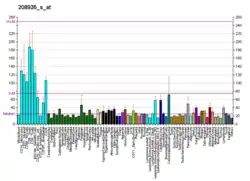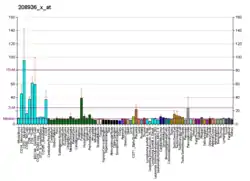| LGALS8 | |||||||||||||||||||||||||||||||||||||||||||||||||||
|---|---|---|---|---|---|---|---|---|---|---|---|---|---|---|---|---|---|---|---|---|---|---|---|---|---|---|---|---|---|---|---|---|---|---|---|---|---|---|---|---|---|---|---|---|---|---|---|---|---|---|---|
 | |||||||||||||||||||||||||||||||||||||||||||||||||||
| |||||||||||||||||||||||||||||||||||||||||||||||||||
| Identifiers | |||||||||||||||||||||||||||||||||||||||||||||||||||
| Aliases | LGALS8, Gal-8, PCTA-1, PCTA1, Po66-CBP, galectin 8 | ||||||||||||||||||||||||||||||||||||||||||||||||||
| External IDs | OMIM: 606099 MGI: 1928481 HomoloGene: 31386 GeneCards: LGALS8 | ||||||||||||||||||||||||||||||||||||||||||||||||||
| |||||||||||||||||||||||||||||||||||||||||||||||||||
| |||||||||||||||||||||||||||||||||||||||||||||||||||
| |||||||||||||||||||||||||||||||||||||||||||||||||||
| |||||||||||||||||||||||||||||||||||||||||||||||||||
| |||||||||||||||||||||||||||||||||||||||||||||||||||
| Wikidata | |||||||||||||||||||||||||||||||||||||||||||||||||||
| |||||||||||||||||||||||||||||||||||||||||||||||||||
Galectin-8 is a protein of the galectin family that in humans is encoded by the LGALS8 gene.[5][6][7]
Function
This gene encodes a member of the galectin family. Galectins are beta-galactoside-binding animal lectins with conserved carbohydrate recognition domains. The galectins have been implicated in many essential functions including development, differentiation, cell-cell adhesion, cell-matrix interaction, growth regulation, apoptosis, and RNA splicing. This gene is widely expressed in tumoral tissues and seems to be involved in integrin-like cell interactions. Alternatively spliced transcript variants encoding different isoforms have been identified.[7]
Galectin-8, interacts with the mTOR regulatory system composed of SLC38A9, Ragulator, RagAB, RagCD.[8] Galectin-8 controls mTOR causing its inactivation and dissociation from damaged lysosomes, hence transducing the breach of the lysosomal membrane to mTOR.[8] The physiological consequences of mTOR inhibition following lysosomal membrane damage[8] encompass autophagy and metabolic switching.
Role in cellular defence
Galectin-8 has recently been shown to have a role in cellular defence, against both bacterial cytosolic infection and vacuolar damage.[9] Many intracellular bacteria, such as S. enterica serovar Typhimurium and S. flexneri prefer to replicate inside and outside of the vacuole safety respectively, yet these vacuoles may become damaged, exposing bacteria to the host cell cytoplasm. It has been shown that the binding of galectin-8 to the damaged vacuole can recruit autophagy adaptors such as NDP52 leading to the formation of an autophagosome and subsequent bacterial destruction.[9] As knockout experiments of galectin-8 leads to more successful cytosolic replication by S. enterica serovar Typhimurium, it is thought that galectin-8 acts as a danger receptor in defence against intracellular pathogens.[9][10]
Engineered galectin-8 assays
Galectin-8 has also been used to study endosomal disruption in the development of nanoscale drug delivery systems. Many drug delivery systems carrying large molecule drugs, such as antisense oligonucleotides, siRNA, peptides, and therapeutic proteins, are engineered to be pH-responsive, and disrupt the endosomal membrane because of the lower pH found within progressively acidifying endosomes. Galectin-8 can be tagged with a fluorophore to track these disrupted endosomal membranes, especially when coupled with automated microscopy.[11]
Interactions
Galectin-8 has been shown to interact with CD49d,[12] CD29[12] and CD49c.[12] It also interacts with components of the mTORC1 complex.[8]
References
- 1 2 3 GRCh38: Ensembl release 89: ENSG00000116977 - Ensembl, May 2017
- 1 2 3 GRCm38: Ensembl release 89: ENSMUSG00000057554 - Ensembl, May 2017
- ↑ "Human PubMed Reference:". National Center for Biotechnology Information, U.S. National Library of Medicine.
- ↑ "Mouse PubMed Reference:". National Center for Biotechnology Information, U.S. National Library of Medicine.
- ↑ Hadari YR, Paz K, Dekel R, Mestrovic T, Accili D, Zick Y (February 1995). "Galectin-8. A new rat lectin, related to galectin-4". The Journal of Biological Chemistry. 270 (7): 3447–53. doi:10.1074/jbc.270.7.3447. PMID 7852431.
- ↑ Su ZZ, Lin J, Shen R, Fisher PE, Goldstein NI, Fisher PB (July 1996). "Surface-epitope masking and expression cloning identifies the human prostate carcinoma tumor antigen gene PCTA-1 a member of the galectin gene family". Proceedings of the National Academy of Sciences of the United States of America. 93 (14): 7252–7. Bibcode:1996PNAS...93.7252S. doi:10.1073/pnas.93.14.7252. PMC 38969. PMID 8692978.
- 1 2 "Entrez Gene: LGALS8 lectin, galactoside-binding, soluble, 8 (galectin 8)".
- 1 2 3 4 Jia J, Abudu YP, Claude-Taupin A, Gu Y, Kumar S, Choi SW, et al. (April 2018). "Galectins Control mTOR in Response to Endomembrane Damage". Molecular Cell. 70 (1): 120–135.e8. doi:10.1016/j.molcel.2018.03.009. PMC 5911935. PMID 29625033.
- 1 2 3 Thurston TL, Wandel MP, von Muhlinen N, Foeglein A, Randow F (January 2012). "Galectin 8 targets damaged vesicles for autophagy to defend cells against bacterial invasion". Nature. 482 (7385): 414–8. Bibcode:2012Natur.482..414T. doi:10.1038/nature10744. PMC 3343631. PMID 22246324.
- ↑ Huang J, Brumell JH (February 2012). "Microbiology: A sweet way of sensing danger". Nature. 482 (7385): 316–7. Bibcode:2012Natur.482..316H. doi:10.1038/482316a. PMID 22337047. S2CID 33971618.
- ↑ Kilchrist KV, Dimobi SC, Jackson MA, Evans BC, Werfel TA, Dailing EA, et al. (February 2019). "Gal8 Visualization of Endosome Disruption Predicts Carrier-Mediated Biologic Drug Intracellular Bioavailability". ACS Nano. 13 (2): 1136–1152. doi:10.1021/acsnano.8b05482. PMC 6995262. PMID 30629431.
- 1 2 3 Hadari YR, Arbel-Goren R, Levy Y, Amsterdam A, Alon R, Zakut R, Zick Y (July 2000). "Galectin-8 binding to integrins inhibits cell adhesion and induces apoptosis". Journal of Cell Science. 113 ( Pt 13) (Pt 13): 2385–97. doi:10.1242/jcs.113.13.2385. PMID 10852818.
Further reading
- Bidon N, Brichory F, Bourguet P, Le Pennec JP, Dazord L (September 2001). "Galectin-8: a complex sub-family of galectins (Review)". International Journal of Molecular Medicine. 8 (3): 245–50. doi:10.3892/ijmm.8.3.245. PMID 11494049.
- Danguy A, Camby I, Kiss R (September 2002). "Galectins and cancer". Biochimica et Biophysica Acta (BBA) - General Subjects. 1572 (2–3): 285–93. doi:10.1016/S0304-4165(02)00315-X. PMID 12223276.
- Bidon-Wagner N, Le Pennec JP (2004). "Human galectin-8 isoforms and cancer". Glycoconjugate Journal. 19 (7–9): 557–63. doi:10.1023/B:GLYC.0000014086.38343.98. PMID 14758080. S2CID 1330672.
- Bassen R, Brichory F, Caulet-Maugendre S, Bidon N, Delaval P, Desrues B, Dazord L (2000). "Expression of Po66-CBP, a type-8 galectin, in different healthy, tumoral and peritumoral tissues". Anticancer Research. 19 (6B): 5429–33. PMID 10697573.
- Hadari YR, Arbel-Goren R, Levy Y, Amsterdam A, Alon R, Zakut R, Zick Y (July 2000). "Galectin-8 binding to integrins inhibits cell adhesion and induces apoptosis". Journal of Cell Science. 113 ( Pt 13) (13): 2385–97. doi:10.1242/jcs.113.13.2385. PMID 10852818.
- Gopalkrishnan RV, Roberts T, Tuli S, Kang D, Christiansen KA, Fisher PB (September 2000). "Molecular characterization of prostate carcinoma tumor antigen-1, PCTA-1, a human galectin-8 related gene". Oncogene. 19 (38): 4405–16. doi:10.1038/sj.onc.1203767. PMID 10980616.
- Bidon N, Brichory F, Hanash S, Bourguet P, Dazord L, Le Pennec JP (August 2001). "Two messenger RNAs and five isoforms for Po66-CBP, a galectin-8 homolog in a human lung carcinoma cell line". Gene. 274 (1–2): 253–62. doi:10.1016/S0378-1119(01)00598-4. PMID 11675018.
- Nagy N, Bronckart Y, Camby I, Legendre H, Lahm H, Kaltner H, et al. (March 2002). "Galectin-8 expression decreases in cancer compared with normal and dysplastic human colon tissue and acts significantly on human colon cancer cell migration as a suppressor". Gut. 50 (3): 392–401. doi:10.1136/gut.50.3.392. PMC 1773143. PMID 11839721.
- Maier C, Rösch K, Herkommer K, Bochum S, Cancel-Tassin G, Cussenot O, et al. (September 2002). "A candidate gene approach within the susceptibility region PCaP on 1q42.2-43 excludes deleterious mutations of the PCTA-1 gene to be responsible for hereditary prostate cancer". European Urology. 42 (3): 301–7. doi:10.1016/S0302-2838(02)00280-4. PMID 12234517.
- Levy Y, Ronen D, Bershadsky AD, Zick Y (April 2003). "Sustained induction of ERK, protein kinase B, and p70 S6 kinase regulates cell spreading and formation of F-actin microspikes upon ligation of integrins by galectin-8, a mammalian lectin". The Journal of Biological Chemistry. 278 (16): 14533–42. doi:10.1074/jbc.M207380200. PMC 5950010. PMID 12569102.
- Ideo H, Seko A, Ishizuka I, Yamashita K (October 2003). "The N-terminal carbohydrate recognition domain of galectin-8 recognizes specific glycosphingolipids with high affinity". Glycobiology. 13 (10): 713–23. doi:10.1093/glycob/cwg094. PMID 12851289.
- Nishi N, Shoji H, Seki M, Itoh A, Miyanaka H, Yuube K, et al. (November 2003). "Galectin-8 modulates neutrophil function via interaction with integrin alphaM". Glycobiology. 13 (11): 755–63. doi:10.1093/glycob/cwg102. PMID 12881409.






